Keith
The best camera is one that still works!
Every time I see Kodachrome images I marvel at how truly beautiful it was ... just extraordinary! it gave ordinary photos an absolutely surreal look.  💕
💕
Richard G
Mentor
Magenta receding down the page already. For such a huge project would you not get a Nikon Ccolscan? I miss that scanner’s software but I’m finding VueScan is good. I’m still wrestling with black and white and my best effort with that was on the Epson flatbed, but Kodachrome do very well and the colour balance is near perfect. You had a great architectural eye from early in your career. Three of the best primes, a new camera and 60 rolls of Kodachrome 25. Such discernment and conviction. We need more of the story!
AlwaysOnAuto
Well-known
I'm along for the ride too, having grown up in Santa Monica from a young age. I've driven on that freeway so many times I can't even count.
The FE was/is a fine choice. Mine still works after having been bought within a few years of when you got yours.
Thank you for sharing this with us here.
I'll go make some more popcorn now...
The FE was/is a fine choice. Mine still works after having been bought within a few years of when you got yours.
Thank you for sharing this with us here.
I'll go make some more popcorn now...
DownUnder
Nikon Nomad
1979. Forty four years ago. When I was young and the world (as well as my life) seemed endless, timeless. Memories. And more memories.
One of your images - #USA02-01. Hollywood and Vine, 01 May 1979 - truly hits home. I too was in LA that year, in my case for an 11 month drive across North America, from Sydney, Australia to Sydney, Nova Scotia in Canada. And a visit with families (I was traveling with an Aussie companion) in New Brunswick in Canada)and New Mexico, where I had lived in the early 1970s.
In eastern Canada we turned our dented two door 1970 Ford Maverick (bought in San Francisco for US$500 which included insurance) round and went West, via Quebec, Montreal and Toronto, where we decided the drive across the Canadian Prairies would be too much for the old car, so we took an easier way across the northern US states. Not as memorable as Arizona, New Mexico, Texas and the southern states, but on that trip we did the mythical Route 66...
We didn't do camping. In those halcyon days the Motel 6 network had basic but entirely adequate rooms for yes, the amazing price of US$6. You had a room, a pillow and a sheet but everything else was charged for, and as I recall many of the reception areas had hard-eyed ladies staring keenly at new arrivals with obvious intent to provide what the tragic Blanche DuBois in Tennessee William's 1940s play (later a film) called "the kindness of strangers".
Digression done with. To return to your image, that 1920s building at Hollywood and Vine was, and may still be, a hotel . I stayed there for my five days in LA. That corner is familiar to me, for what fleeting memories I have left of Los Angeles. I did much walking around Beverly Hills to seek out what little was left of the old (pre Second World War) architecture of California film land. Back then one could still trek the sidewalks and look at film stars' gala (and often garish) residences, alas, now no longer possible.
I had two cameras - a Nikkormat FTN with a 50/2.0, a 35/2.8 and a 135/3.5 and a Rolleiflex 3.5E2. I recall I bought an old Speed Graphic in a pawn shop in Phoenix, Arizona but I no longer recall what happened to it. Film was dirt cheap. I bought it at K-Mart. Kodachrome could be processed by independent labs so I shot a lot of K64 for color and 120 B&W, Kodak Verichrome Pan, Plus-X and Tri-X.
The long drive across to eastern Canada took us three months. I think I saw every Confederate battlefield on the way. I didn't keep detailed notes back then, so almost all my Civil War images are of rows of cannons, old wagons, stone fences and other scenes I can now no longer identify as to place and dates of battle.
The going was truly good in those days and those of us who were young and sufficiently adventurous enough to enjoy it had experiences today's 'homogenised' travelers.
I too must get round to scanning my '00s of slides. I've not looked at any of them for some years, but I reckon the Kodachromes have survived. Not so much my Ektachromes and Agfachromes, but the time passes and all things change.
This is Lyn's thread and not mine, so I will stop 'nostalging' now.
Except to say I believe everyone who is able to (and can afford to), should do at least one such leisurely, unscheduled trip from one place to another place, defined and definite, somewhere in the world, at least one time in life. It's a formative experience and it will expand your connection to the global identify, by an amazing amount.
Many thanks to you, Lyn, for your thread - and above all for the effort and time you'll be putting into scanning all your slides.
One of your images - #USA02-01. Hollywood and Vine, 01 May 1979 - truly hits home. I too was in LA that year, in my case for an 11 month drive across North America, from Sydney, Australia to Sydney, Nova Scotia in Canada. And a visit with families (I was traveling with an Aussie companion) in New Brunswick in Canada)and New Mexico, where I had lived in the early 1970s.
In eastern Canada we turned our dented two door 1970 Ford Maverick (bought in San Francisco for US$500 which included insurance) round and went West, via Quebec, Montreal and Toronto, where we decided the drive across the Canadian Prairies would be too much for the old car, so we took an easier way across the northern US states. Not as memorable as Arizona, New Mexico, Texas and the southern states, but on that trip we did the mythical Route 66...
We didn't do camping. In those halcyon days the Motel 6 network had basic but entirely adequate rooms for yes, the amazing price of US$6. You had a room, a pillow and a sheet but everything else was charged for, and as I recall many of the reception areas had hard-eyed ladies staring keenly at new arrivals with obvious intent to provide what the tragic Blanche DuBois in Tennessee William's 1940s play (later a film) called "the kindness of strangers".
Digression done with. To return to your image, that 1920s building at Hollywood and Vine was, and may still be, a hotel . I stayed there for my five days in LA. That corner is familiar to me, for what fleeting memories I have left of Los Angeles. I did much walking around Beverly Hills to seek out what little was left of the old (pre Second World War) architecture of California film land. Back then one could still trek the sidewalks and look at film stars' gala (and often garish) residences, alas, now no longer possible.
I had two cameras - a Nikkormat FTN with a 50/2.0, a 35/2.8 and a 135/3.5 and a Rolleiflex 3.5E2. I recall I bought an old Speed Graphic in a pawn shop in Phoenix, Arizona but I no longer recall what happened to it. Film was dirt cheap. I bought it at K-Mart. Kodachrome could be processed by independent labs so I shot a lot of K64 for color and 120 B&W, Kodak Verichrome Pan, Plus-X and Tri-X.
The long drive across to eastern Canada took us three months. I think I saw every Confederate battlefield on the way. I didn't keep detailed notes back then, so almost all my Civil War images are of rows of cannons, old wagons, stone fences and other scenes I can now no longer identify as to place and dates of battle.
The going was truly good in those days and those of us who were young and sufficiently adventurous enough to enjoy it had experiences today's 'homogenised' travelers.
I too must get round to scanning my '00s of slides. I've not looked at any of them for some years, but I reckon the Kodachromes have survived. Not so much my Ektachromes and Agfachromes, but the time passes and all things change.
This is Lyn's thread and not mine, so I will stop 'nostalging' now.
Except to say I believe everyone who is able to (and can afford to), should do at least one such leisurely, unscheduled trip from one place to another place, defined and definite, somewhere in the world, at least one time in life. It's a formative experience and it will expand your connection to the global identify, by an amazing amount.
Many thanks to you, Lyn, for your thread - and above all for the effort and time you'll be putting into scanning all your slides.
Archiver
Mentor
This is a wonderful thread with a truly cool back story. I love that in 1979 you were already taking the kinds of photos that became much more common after digital photography, due to the price of film. None of our family photos are like this, they are all the usual daft posed photos in front of whatever landmark. We went to America in 1988 and hardly any of the photos show buildings, surrounds or activities.
But my question is: what became of the young woman you met on the flight?
But my question is: what became of the young woman you met on the flight?
lynnb
Mentor
Many thanks for your kind and thoughtful comments! I agree with Keith, Kodachrome was a wonderful film. I have other Agfachrome and Perutz slides from those decades in the 60s-80s and they haven't fared nearly as well, with significant fading and colour shifts, as well as fungus. I use wooden slide boxes.
Richard, I can't afford a better scanner. A few months ago an old and good friend told me he's leaving me his Imacon scanner when he passes away, but for his sake I hope that's another decade. My V700 with original EpsonScan software is running on a legacy Mac Mini which I keep for the purpose.
DownUnder: great story and I look forward to seeing the pictures - please start a thread!
Archiver: I never kept in touch with the young lady, but I did stay in contact with another of the young women on the trip, her name was Vicki and she hailed from Melbourne. Quite a crazy lady, lots of fun and good company. For quite a few years I'd visit her in Melbourne whenever cheap airfares were advertised .
.
So back to my trip... the camping tour travelled anticlockwise around the US starting and ending in LA. Thirteen Aussies and New Zealanders plus a driver in a Dodge Maxi Wagon with suitcases, backpacks, tents and cooking gear on the roof rack. You'll see the itinerary as this thread unfolds...
Richard, I can't afford a better scanner. A few months ago an old and good friend told me he's leaving me his Imacon scanner when he passes away, but for his sake I hope that's another decade. My V700 with original EpsonScan software is running on a legacy Mac Mini which I keep for the purpose.
DownUnder: great story and I look forward to seeing the pictures - please start a thread!
Archiver: I never kept in touch with the young lady, but I did stay in contact with another of the young women on the trip, her name was Vicki and she hailed from Melbourne. Quite a crazy lady, lots of fun and good company. For quite a few years I'd visit her in Melbourne whenever cheap airfares were advertised
So back to my trip... the camping tour travelled anticlockwise around the US starting and ending in LA. Thirteen Aussies and New Zealanders plus a driver in a Dodge Maxi Wagon with suitcases, backpacks, tents and cooking gear on the roof rack. You'll see the itinerary as this thread unfolds...
lynnb
Mentor
#USA01-32 downtown LA, 01 May 1979. The street sign says "Grand". I was struck by the number and size of US flags on buildings - quite unlike Australia where flags were uncommon at the time.
I'm still trying to work out who/what the guy in the hat is on the left.
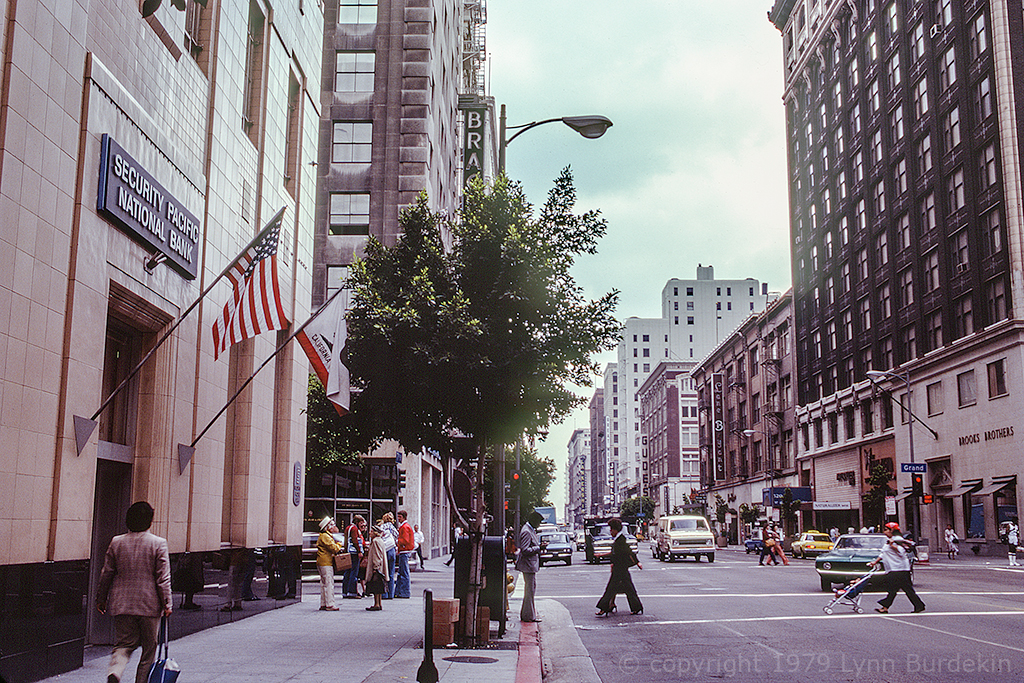
I'm still trying to work out who/what the guy in the hat is on the left.

Last edited:
lynnb
Mentor
#USA01-35 7th Street, downtown LA, 01 May 1979
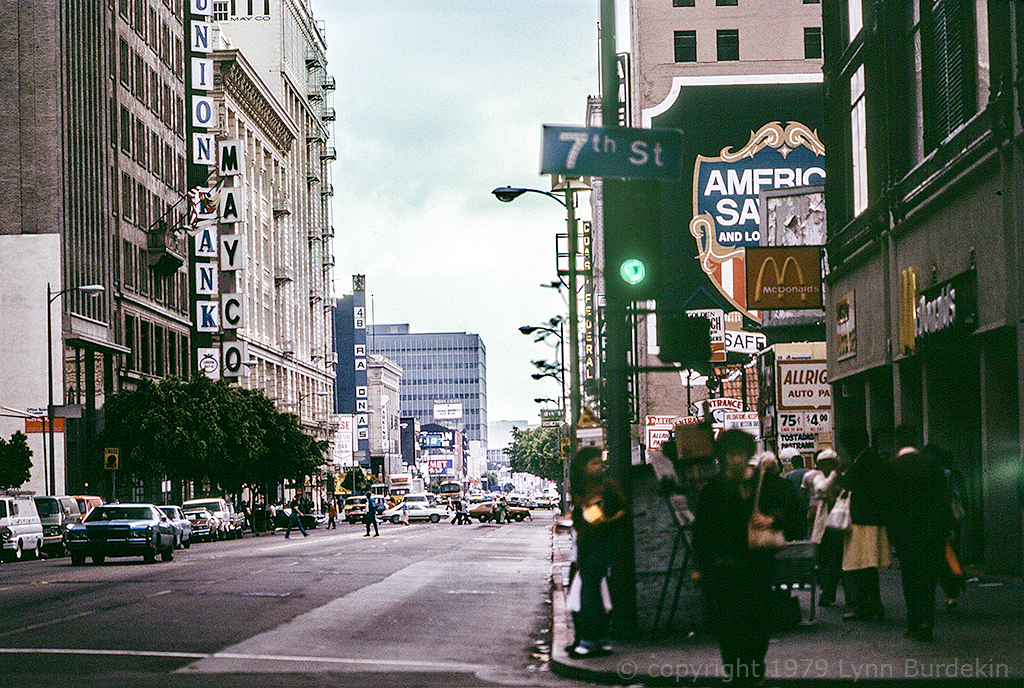

DownUnder
Nikon Nomad
Two more images that evoked a tonne of memories for me. I too was there, and I walked those sidewalks...
Gads, Lynb, you are an absolute wizard. Keep them coming, please!
Gads, Lynb, you are an absolute wizard. Keep them coming, please!
Guth
Appreciative User
My favorite thing about image #USA02-01 is the guy midway through the crosswalk in full 70's regalia: a turtleneck, bell bottoms and what appear to be a pair of Earth Shoes. Classic.#USA02-01. Hollywood and Vine, 01 May 1979
lynnb
Mentor
#USA02-02 Hollywood Blvd and Las Palmas, LA, 01 May 1979
Check out those cars. It was a different world... The corner building on the right signposted Swensen's is now the Hollywood Bazaar Food Market according to Google street view. Visiting Hollywood Boulevarde was a must-see in LA. It was here that I had my first (and only) run-in with the cops. I had decided to cross the road, so casually stepped off the kerb after checking for traffic as one does in Sydney. A police car came to a screeching halt and an officer admonished me for jaywalking. I apologised profusely explaining that I was an Australian tourist just arrived in LA and crossing the street was something one did back home in Sydney. The officer told me it wasn't allowed in LA and let me go with a warning!
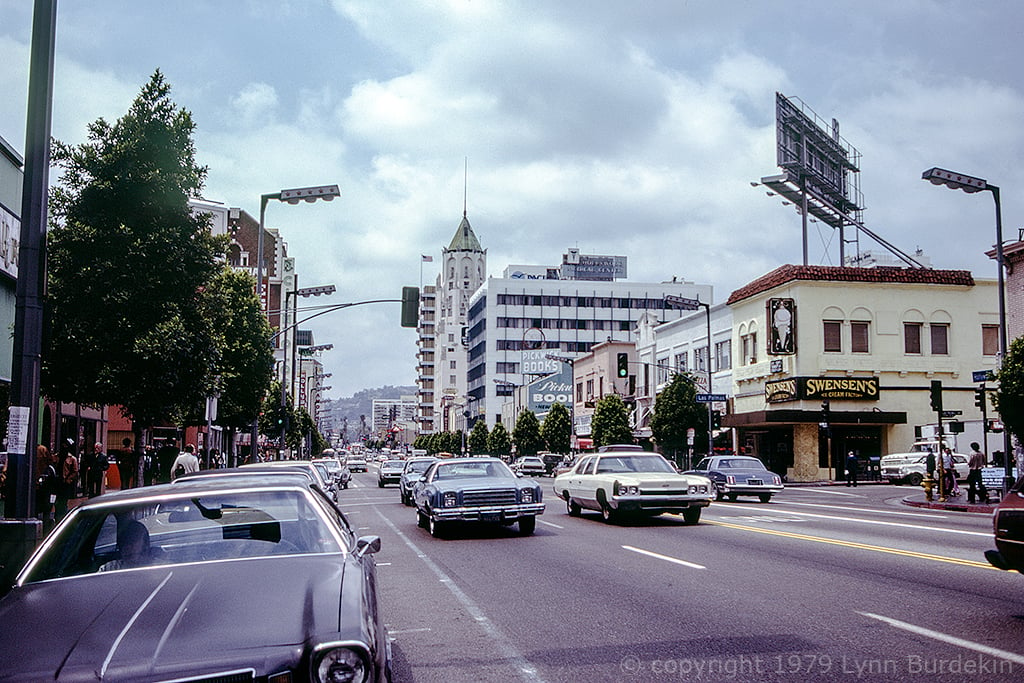
Check out those cars. It was a different world... The corner building on the right signposted Swensen's is now the Hollywood Bazaar Food Market according to Google street view. Visiting Hollywood Boulevarde was a must-see in LA. It was here that I had my first (and only) run-in with the cops. I had decided to cross the road, so casually stepped off the kerb after checking for traffic as one does in Sydney. A police car came to a screeching halt and an officer admonished me for jaywalking. I apologised profusely explaining that I was an Australian tourist just arrived in LA and crossing the street was something one did back home in Sydney. The officer told me it wasn't allowed in LA and let me go with a warning!

Last edited:
lynnb
Mentor
#USA02-05 Hollywood Boulevarde, LA, 01 May 1979
Sophia Loren, Marilyn Monroe and Jane Russell in the one frame. Now I knew I really was in the city of dreams.
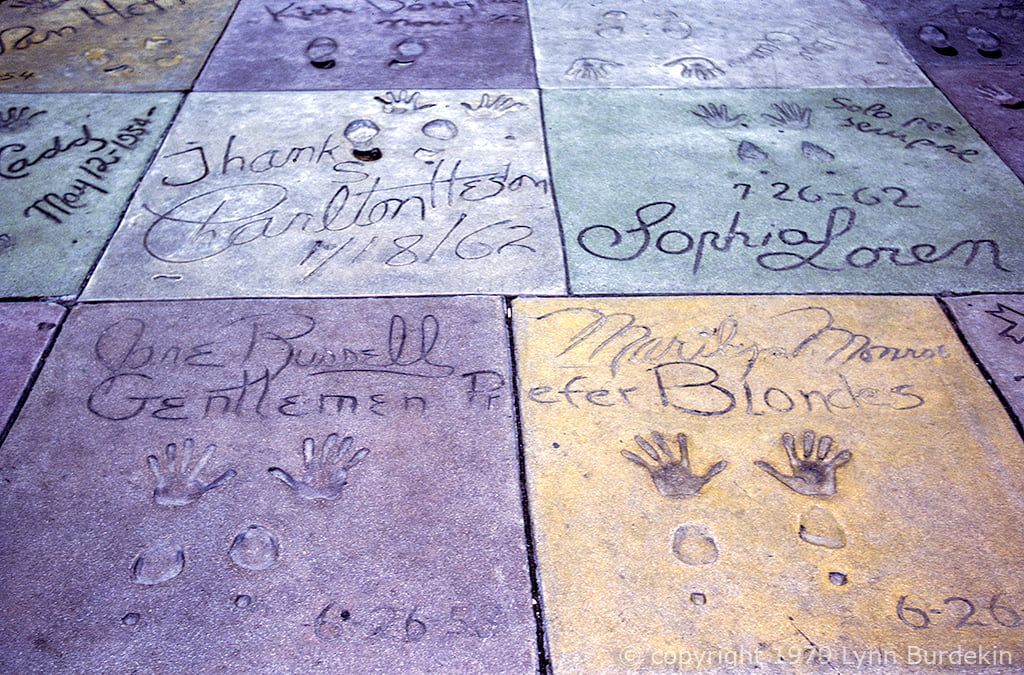
Sophia Loren, Marilyn Monroe and Jane Russell in the one frame. Now I knew I really was in the city of dreams.

Evergreen States
Pierre Saget (they/them)
Not to beat a dead horse, but the crime of jaywalking become part of the legal code in many cities in the early days when cars started populating streets. American streets - and cities themselves - gradually got overtaken by cars over the 20th century. I forgot if it was in the 1920s or 1930s when these were enacted, but a "jay" was slang for a backward country bumpkin, so a jaywalker signified that the people who cross the street anywhere instead of at crosswalks was an unsophisticated dimwit. Jaywalking laws were campaigned for by the nascent automotive industry and by car clubs and they tend to be enforced in a racially disproportionate manner in practice. Some cities in the US and Canada have started repealing their jaywalking laws for these and other reasons. If I'm not mistaken, the entire province of Ontario repealed all local jaywalking laws. My home state of Washington almost did in the last legislative session but it didn't pass.#USA02-02 Hollywood Blvd and Las Palmas, LA, 01 May 1979
Check out those cars. It was a different world... The corner building on the right signposted Swensen's is now the Hollywood Bazaar Food Market according to Google street view. Visiting Hollywood Boulevarde was a must-see in LA. It was here that I had my first (and only) run-in with the cops. I had decided to cross the road, so casually stepped off the kerb after checking for traffic as one does in Sydney. A police car came to a screeching halt and an officer admonished me for jaywalking. I apologised profusely explaining that I was an Australian tourist just arrived in LA and crossing the street was something one did back home in Sydney. The officer told me it wasn't allowed in LA and let me go with a warning!

These pictures are a real time capsule and they remind me a lot of Stephen Shore, William Eggleston and Lee Friedlander. Not aesthetically, just the subject matter. I'm glad you got to have such a fun time visiting our country. It's a strange and beautiful place.
Evergreen States
Pierre Saget (they/them)
The landscape of hotels and restaurants servicing travelers has succumbed to corporate consolidation and standardization. The motor hotel, or motel, was a staple of midcentury Americana. Many were independently operated. We had B&Bs too. But it's mostly chains now. The US has many varied natural landscapes but the urban landscapes outside the old downtowns can take on an alienating sameness - you see the same fast food restaurants and diners, the same hotels and motels, the same gas stations. Everywhere you go you're guaranteed a more or less consistent experience - which has it's advantages, don't get me wrong! But it's a lot harder to find adventure. It's still there, but you do have to look harder than you did back in the 1970s and earlier.The going was truly good in those days and those of us who were young and sufficiently adventurous enough to enjoy it had experiences today's 'homogenised' travelers.
lynnb
Mentor
Thanks for the interesting background. I certainly had a fun time, and I was impressed by the friendly hospitality of Americans I met everywhere on my travels. I was delighted and amazed to be offered a bed for the night by complete strangers I had met on the street while travelling alone, not once but several times.Not to beat a dead horse, but the crime of jaywalking become part of the legal code in many cities in the early days when cars started populating streets. American streets - and cities themselves - gradually got overtaken by cars over the 20th century. I forgot if it was in the 1920s or 1930s when these were enacted, but a "jay" was slang for a backward country bumpkin, so a jaywalker signified that the people who cross the street anywhere instead of at crosswalks was an unsophisticated dimwit. Jaywalking laws were campaigned for by the nascent automotive industry and by car clubs and they tend to be enforced in a racially disproportionate manner in practice. Some cities in the US and Canada have started repealing their jaywalking laws for these and other reasons. If I'm not mistaken, the entire province of Ontario repealed all local jaywalking laws. My home state of Washington almost did in the last legislative session but it didn't pass.
These pictures are a real time capsule and they remind me a lot of Stephen Shore, William Eggleston and Lee Friedlander. Not aesthetically, just the subject matter. I'm glad you got to have such a fun time visiting our country. It's a strange and beautiful place.
lynnb
Mentor
#USA02-08 LA skyline from Griffith Observatory, 01 May 1979
A visit to Griffith Observatory on my first full day in LA was an unexpected highlight - I had never been to a planetarium show before, and having always been interested in astronomy, the show blew me away. A group of six of us soon-to-be fellow travellers (all staying at a cheap airport motel before departure on our six week tour) had caught a bus to Hollywood and then a cab to the observatory. My travel diary says we got ripped off by the cab driver.
Outside, I took some pictures of the LA skyline, through the smog. An immediate difference between LA and my hometown of Sydney was the roof and building colours - at the time most Sydney houses were red brick with red tile roofs, and while there are quite a few red tile roofs in this picture, mostly it's a sea of white.
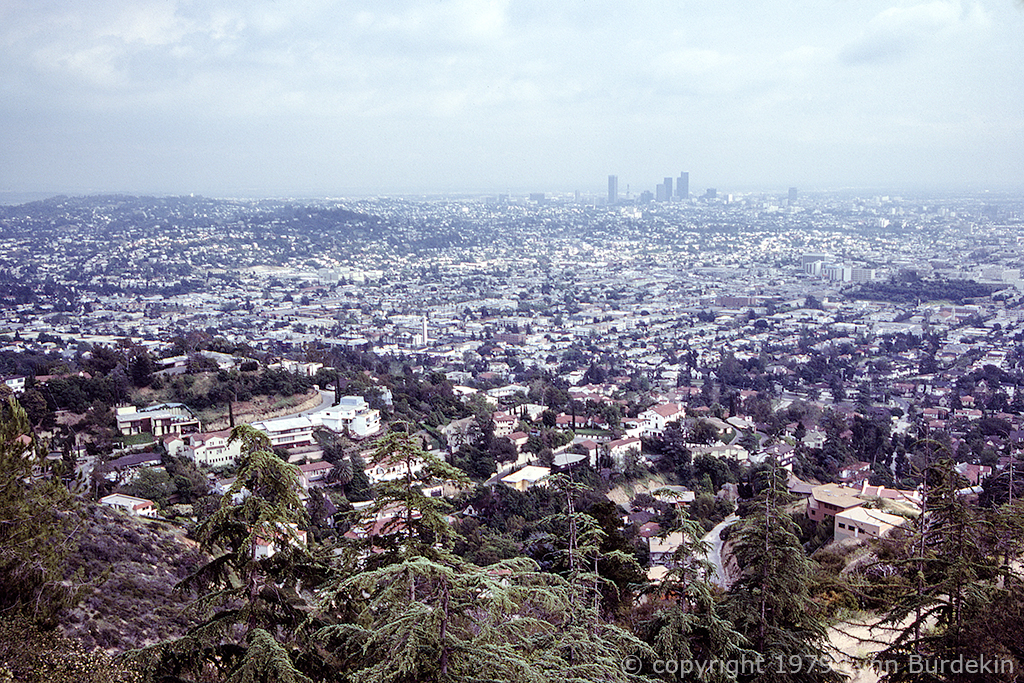
A visit to Griffith Observatory on my first full day in LA was an unexpected highlight - I had never been to a planetarium show before, and having always been interested in astronomy, the show blew me away. A group of six of us soon-to-be fellow travellers (all staying at a cheap airport motel before departure on our six week tour) had caught a bus to Hollywood and then a cab to the observatory. My travel diary says we got ripped off by the cab driver.
Outside, I took some pictures of the LA skyline, through the smog. An immediate difference between LA and my hometown of Sydney was the roof and building colours - at the time most Sydney houses were red brick with red tile roofs, and while there are quite a few red tile roofs in this picture, mostly it's a sea of white.

Last edited:
lynnb
Mentor
#USA02-16 rental Mustang, 02 May 1979.
Next day the tour group staying at the motel had different ideas on where to go. They wanted to catch buses but I thought a rental car would be more efficient given LA's geography and poor public transport. So I rented a Mustang for USD$17.95/day from Dollar car rental, but the others were reluctant to drive and decided to go sightseeing by bus. I asked someone to take my picture before we parted ways. I had also met a girl in a drug store checkout queue and had asked her out to dinner, so the Mustang seemed a good and necessary idea. A Mustang would've been impossibly expensive to rent back in Sydney. I'd never driven a V8 modern car before, or driven on the right hand side of the road. I wasn't going to let those small details get in the way of a good night out. I bought a street map, and I was set to go.
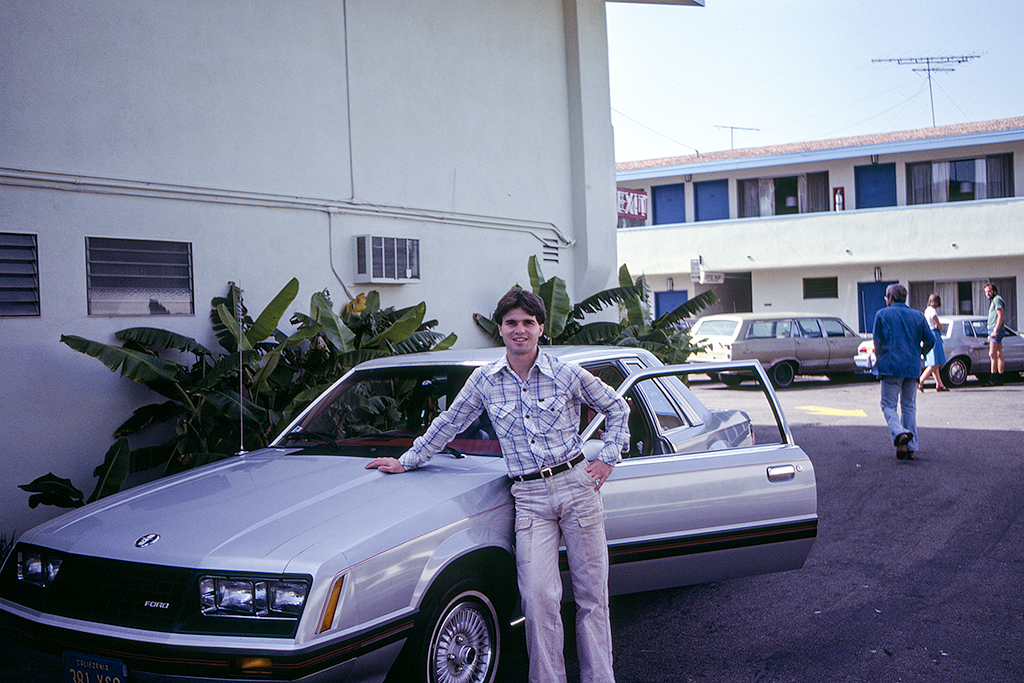
Next day the tour group staying at the motel had different ideas on where to go. They wanted to catch buses but I thought a rental car would be more efficient given LA's geography and poor public transport. So I rented a Mustang for USD$17.95/day from Dollar car rental, but the others were reluctant to drive and decided to go sightseeing by bus. I asked someone to take my picture before we parted ways. I had also met a girl in a drug store checkout queue and had asked her out to dinner, so the Mustang seemed a good and necessary idea. A Mustang would've been impossibly expensive to rent back in Sydney. I'd never driven a V8 modern car before, or driven on the right hand side of the road. I wasn't going to let those small details get in the way of a good night out. I bought a street map, and I was set to go.

Last edited:
lynnb
Mentor
#USA02-25 packing the van in preparation for departure on a six week adventure tour, LA, 04 May 1979. Thirteen Aussies and Kiwis plus a tour guide/driver in a Dodge Maxi Wagon. The company ran multiple tours departing on the same day. By the time we got to NYC the suspension needed urgent repairs.
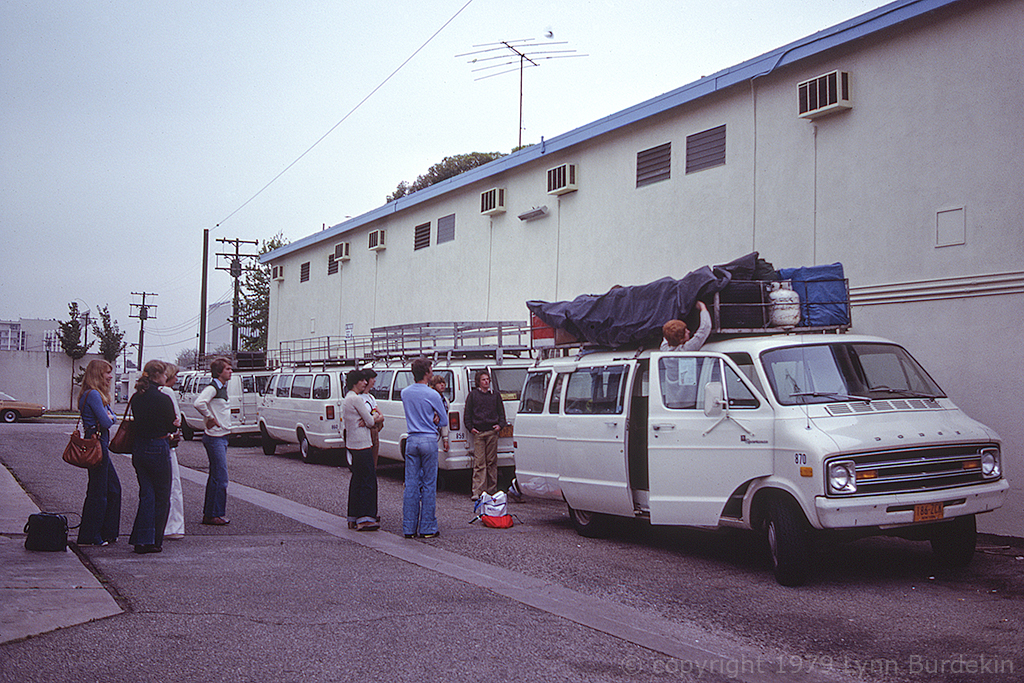

lynnb
Mentor
#USA03-27 performers at Disneyland, LA, 04 May 1979.
This is the only picture of Disneyland I will inflict on you. Some movement with the slow shutter speed.
After this, the real adventure begins.
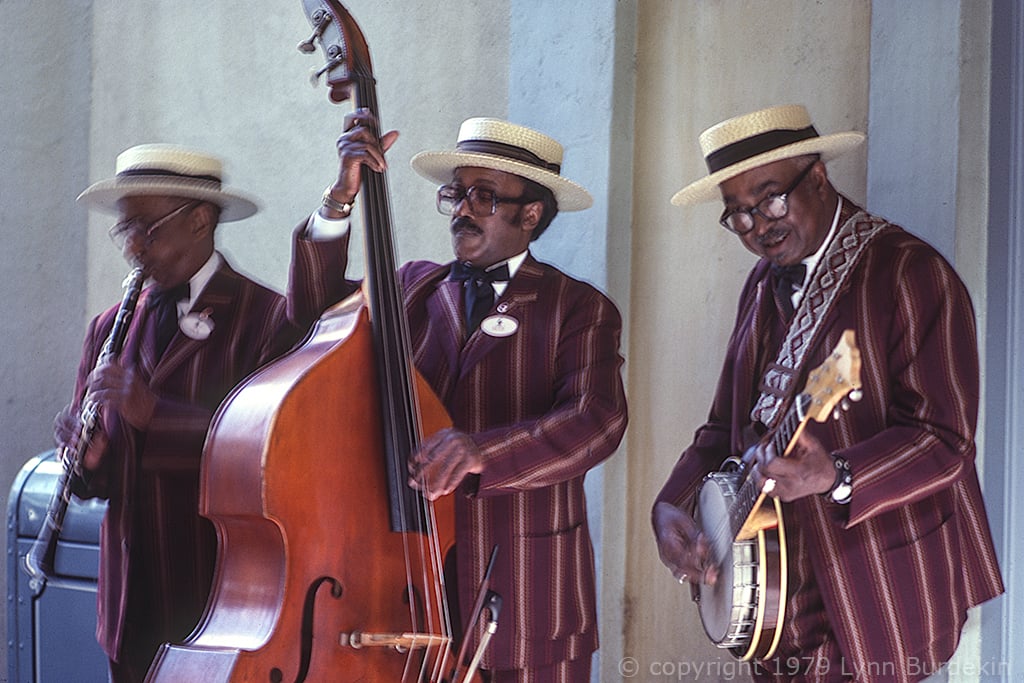
This is the only picture of Disneyland I will inflict on you. Some movement with the slow shutter speed.
After this, the real adventure begins.

lynnb
Mentor
#USA03-29 setting up camp in the Featherly Regional Park, Santa Ana Canyon, 04 May 1979.
Finally on the road.
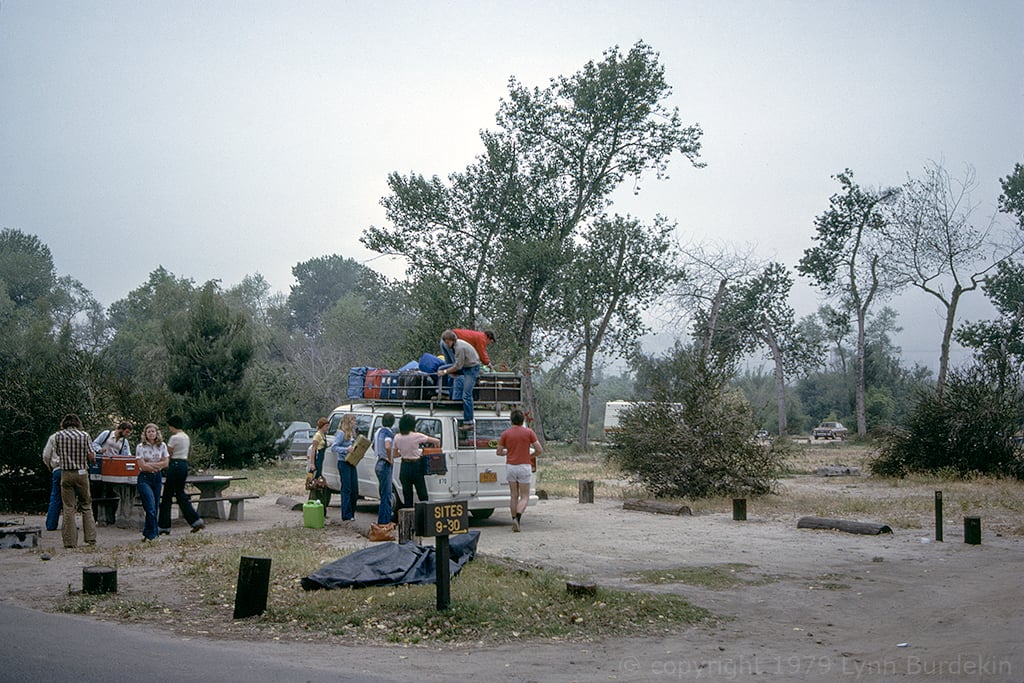
Finally on the road.

Share:
-
This site uses cookies to help personalise content, tailor your experience and to keep you logged in if you register.
By continuing to use this site, you are consenting to our use of cookies.

